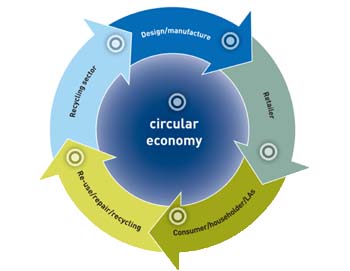Various shades of economic programs and concerns fill This Week in Sharing.
From Resource Magazine: "The Ellen MacArthur Foundation has today (6 February), launched the Circular Economy 100 (CE100), a three-year programme aimed at bringing together a ‘network of 100 leading companies globally to facilitate development and commitment to new circular economy projects’. As part of the programme, companies will identify ways in which to promote a circular economy and result in ‘an aggregated economic benefit of $10 billion (£6.4 billion) by 2015'."
From Radar O'Reilly: "If you had 10 million pounds to spend on open data research, development and startups, what would you do with it? That’s precisely the opportunity that Gavin Starks has been given as the first CEO of the Open Data Institute (ODI) in the United Kingdom. The ODI, which officially opened last September, was founded by Sir Tim Berners-Lee and Professor Nigel Shadbolt. The independent, non-partisan, 'limited by guarantee' nonprofit is a hybrid institution focused on unlocking the value in open data by incubating startups, advising governments, and educating students and media."
From Co.Exist: "The most effective way I know to drive philanthropy at a tremendous scale and develop long-term economic vitality through giving is by embracing a philosophy I call Entrepreneurial Philanthropy. At its core, Entrepreneurial Philanthropy is designed to support innovation that creates sustainable, thriving economies in communities with tremendous need. The first step is to identify problems that impact hundreds of millions–or even more–people who are in need. Then, as Entrepreneurial Philanthropists, we should set our sights on finding the smartest people who can help us overcome these huge challenges by creating ecosystems of economic development that stimulate long-term vitality. By focusing on the big issues of our world today, enlisting support and contributions from experts, and leveraging scalable solutions, we are able to address the core of each challenge and subsequently improve the health and well-being of an entire community, village, or town."

From OpenSource.com: "In his excellent article The Nature of the Firm (1937), Ronald Harry Coase, the great British economist, makes a strong argument that one of the reasons for the structure of vertically integrated organizations is the 'cost of transaction.' Perform a transaction inside your firm only if it is cheaper than performing it externally or in the marketplace. The Internet boom and the development of open source software and pooled infrastructure has made it possible for web-based businesses to keep these transaction costs low. Don Tapscot, the author of Wikinomics, dissects this idea: 'Transaction costs still exist, but now they're often more onerous in corporations than in the marketplace.'"
From Streetsblog: "Nadine Lemmon at the Tri-State Transportation Campaign reports that there’s a $20 million transit raid lurking in Governor Cuomo’s 2013 executive budget:
This $20 million diversion of funds comes from a pot of money that is statutorily dedicated to cover the operating needs of the MTA. The Executive Budget, however, declared that this $20 million diversion is 'surplus,' but there is no explanation of how funds are determined to be surplus.
The 2013 transit raid isn’t as big as recent Albany raids, which were $100 million or larger. And unlike the 2009 raid it won’t lead to service cuts, since the MTA’s dedicated tax revenues are beating projections. Still, that’s $20 million the MTA won’t have to restore service."
From The Atlantic Cities: "On the one hand, a growing number of economists extol the benefits of greater high-rise construction as a panacea for everything from innovation and job creation to affordable housing. Writing in the pages of The Atlantic in 2011, Harvard's Edward Glaeser points out that 'tall buildings enable the human interactions that are at the heart of economic innovation, and of progress itself.' On the other hand, urbanists like Natural Resources Defense Council's Kaid Benfield (also a frequent Cities contributor) as well as the Urban Land Institute's Edward McMahon counter that density can be better achieved 'without high-rises.' As McMahon noted last year, 'one block of an older neighborhood might include a community theatre, a coffee shop, an art gallery, two restaurants, a bicycle shop, 10 music rehearsal studios, a church, 20 apartments and a couple of bars, and all with much more 24/7 activity and intensity of use than one block of (much taller) office buildings.'"









